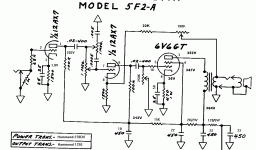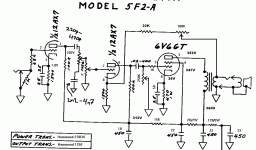And how about the kiviak, did you like that? 😀
Does Fender have a new 2019 version, or are we talking about the once from 2007 or so?
I'm not sure if you're looking for an amp that is physically small, or one that is playable at very low volume. If it's the latter, consider the (solid state) Boss Katana 50. In the past I have never heard any solid-state electric guitar amp worth buying, but this one seems to be an enormous improvement on all the previous few decades of crappy-sounding digital modelling amps.
-Gnobuddy
It's the 2007 version.
I just play at home, so my ideal amp is not very loud. So 5watters are my usable max.
I already have a Katana 50, it's really good. But I like to play around with tube amps. They... just feel different. Experimenting a lot with them, probably too much.
At the moment I have this Harley Benton GA5, a Fender Champ 600 and that Ampro projector amp in the other thread.
They are just so fun to play with 🙂
Enjoying the Fender most though.
I agree! And I'm in the same boat - I live in an apartment, so guitar volume has to stay very low for the sake of my neighbours....I like to play around with tube amps. They... just feel different.
I built a 2-watt push-pull valve guitar amp a few years ago, and it was far too loud to overdrive at home. Recently I bread-boarded an experimental valve amp with only about 200 mW (that's 0.2 W) of output power, and even that was too loud to use at night, though maybe okay during the day. I wasn't entirely happy with the sound, either.
Getting good valve guitar tone at low volume is still a challenge!
-Gnobuddy
Take a look at post #9 by J.M. Fahey in this thread: Attenuator for a 15W to 25W guitar amp...building myself an attenuator soon though.
It's very simple, and it contains a key ingredient: resistor R3. This raises the output impedance of the attenuator, which makes the speaker behave more like it does when connected directly to the original valve guitar amp. This happens because valve guitar amps have a high output impedance, unlike 99% of solid-state amplifiers.
Most of the guitar amp attenuator designs out there seem to miss this fairly key idea - the attenuator itself lowers the output impedance, and this has the unplanned-for side effect of cutting down treble from the guitar speaker.
diyAudio user John H made some very interesting attenuators and measured them, using the same concept as Fahey's attenuator - a high output impedance: Simple Attenuators - Design And Testing | Page 4 | MarshallForum.com
-Gnobuddy
I'm looking at building this design:Take a look at post #9 by J.M. Fahey in this thread: Attenuator for a 15W to 25W guitar amp
It's very simple, and it contains a key ingredient: resistor R3. This raises the output impedance of the attenuator, which makes the speaker behave more like it does when connected directly to the original valve guitar amp. This happens because valve guitar amps have a high output impedance, unlike 99% of solid-state amplifiers.
Most of the guitar amp attenuator designs out there seem to miss this fairly key idea - the attenuator itself lowers the output impedance, and this has the unplanned-for side effect of cutting down treble from the guitar speaker.
diyAudio user John H made some very interesting attenuators and measured them, using the same concept as Fahey's attenuator - a high output impedance: Simple Attenuators - Design And Testing | Page 4 | MarshallForum.com
-Gnobuddy
https://guitar.com/guides/diy-workshop/diy-workshop-build-your-own-attenuator/
I think I'd like it to be variable.
I went down that same road some years ago. First I built a switchable fixed attenuator, then a variable one using an L-pad, because the fixed attenuator never had just the right amount of attenuation.I'm looking at building this design:
DIY Workshop: How To Build Your Own Attenuator - Guitar.com | All Things Guitar
Unfortunately, the L-pad, while quick and easy, doesn't control the output impedance to the speaker. I found it worked fine for small amounts (a few dB) of attenuation, but if you attenuated the signal by more than that, the guitar tone suffered. At the time, I didn't know why this was the case.
The switchable treble boost capacitor in this (guitar dot com) design is probably an attempt to fix this. I haven't tried that, so let's hope it works well enough to make you happy.
I think I still have a couple of L-pads lying around unused, so if you find that the added treble boost cap fixes the "tone suck" problem, I might try one of my L-pads again.
-Gnobuddy
>because the fixed attenuator never had just the right amount of attenuation
+1
When I want to go quiet I often use another little box I did, a kind of Herzog box which allows me to plug in about any amp I have until 50W then send the signal to another (clean) amp. To my ears I can get better attenuation from it, and by using the level knob I can control the amount of drive.
Few weeks ago I was looking to built myself one of these MASS attenuator with a speaker motor but I read somewhere they won't be better than LPad concerning high frequencies.
I don't know if a solution exists to get this variable attenuation perfect.
+1
Once I burned a 25W LPad on my Traynor YGM3, be sure to choose one with enough power for your amplifier. I've built this exact attenuator (with the treble boost switch), stereo LPad for a switchable 4/8 ohm, I built mine inside an old computer power supply box and use it for about 6 years now, not bad.. like Gno says the more attenuated and the more tone will suffer, can be 'slightly' corrected with the switch, but tone is also about air moving so not that easy to get that 'punch' while attenuated. On low watter amps I found this to work okay but it's not the same for bigger amps.I'm looking at building this design:
DIY Workshop: How To Build Your Own Attenuator - Guitar.com | All Things Guitar
I think I'd like it to be variable.
When I want to go quiet I often use another little box I did, a kind of Herzog box which allows me to plug in about any amp I have until 50W then send the signal to another (clean) amp. To my ears I can get better attenuation from it, and by using the level knob I can control the amount of drive.
Few weeks ago I was looking to built myself one of these MASS attenuator with a speaker motor but I read somewhere they won't be better than LPad concerning high frequencies.
I don't know if a solution exists to get this variable attenuation perfect.
A simple variation of the single-knob tone found in the Princeton can be made so it is not interactive. If the tone stack sees a relatively constant impedance, which would be the top of a volume potentiometer instead of into the wiper of the volume potentiometer, it is not interactive, and works well.
The pic on the right is the modified version. Here the first little cap (220p - 470pF) also serves as coupling cap, so save a few pennies as well.
The pic on the right is the modified version. Here the first little cap (220p - 470pF) also serves as coupling cap, so save a few pennies as well.
Attachments
Thanks for the input!The pic on the right is the modified version.
The modified control seems to be the treble half of a passive Baxandall. It looks like the modified (improved) treble control does come with a lot more insertion loss, though.
Looking at the 10:1 ratio of cap values on the two ends, I would expect this modified tone control will have its "flat" setting at roughly 20 dB insertion loss (pot one-tenth of the way up from ground, which also happens to be half-rotation in a log pot.)
-Gnobuddy
Last edited:
Yes it does drop 20dB when set 'flat' but in my version of single 6V6 wimpy amp the gain is more than enough. Besides most gitarst tend to have the tone about 3/4 up so the attenuation is not so bad. More than enough gain for complete crunch and easy to get feeding between gitar and speaker.
One might experiment a little and use other ratios of 1:10 cap values. For instance 220p and 1nF. A single knob tone control is mostly a rough trim anyways.
One might experiment a little and use other ratios of 1:10 cap values. For instance 220p and 1nF. A single knob tone control is mostly a rough trim anyways.
I just looked up the schematic Rasped referred to in post #1, and you're quite right, it was designed with enough gain to cope with a lossy tone-stack....in my version of single 6V6 wimpy amp the gain is more than enough.
-Gnobuddy
- Status
- Not open for further replies.
- Home
- Live Sound
- Instruments and Amps
- Single pot tone stack (EL84)

